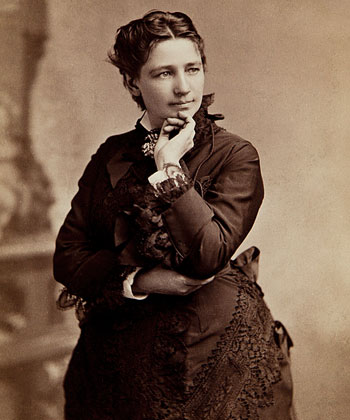Victoria Woodhull
First Woman to run for US President
Born: 1838 in Homer, Ohio
Died: 1927 in London, England
Education: Dropped out of school at 11
Year She Ran for President: 1870
Age When She Ran for President: 32
Party: Equal Rights Party
Background
Victoria Claflin Woodhull would become a trailblazer for generations of women. Her entire life and political journey were unconventional. One of ten children, she started elementary school at the age of eight and attended sporadically for three years before dropping out (Greenspan). Woodhull started as a jack-of-all-trades at a young age in order to help support her family. As a child, along with one of her sisters, Tennessee, she was forced by her father to travel with him as a revivalist child preacher and a fortune teller (Felsenthal). At the age of 14, she married, but divorced 11 years later, a controversial move in the 19th Century ("Woodhull"). By 1868, the sisters had moved to New York City. Soon after, both of the sisters started work for Cornelius Vanderbilt, the famed railroad tycoon, as his clairvoyants.
The move to New York and the working relationship with Vanderbilt proved to be beneficial to the sisters. With Vanderbilt's backing in 1870, the sisters became the first female stockbrokers on Wall Street with their firm, Woodhull, Clafin & Co. (Greenspan). However, the firm was never granted a seat on the New York Stock Exchange. In the same year, Woohull and Clafin started their own newspaper, Woohull and Clafin's Weekly, which would focus on women suffrage and labor reforms ("Woodhull").
It was in 1869 when Woodhull found her spark for politics. Woodhull attended a women's suffrage convention, which inspired her to fight for the cause, taking on a leadership role. After befriending Massachusetts congressman Benjamin Butler, she became the first woman in history to testify before a committee of the US House of Representatives. In her testimony before the House Judiciary Committee, Woodhull declared that women had already won the right to vote under the recently-enacted 14th and 15th amendments, and stated that, "the citizen who is taxed should also have a voice in the subject matter of taxation" (Greenspan).
In April 1970, Woodhull announced her candidacy for president of the United States, becoming the first woman in history to do so. Her platform was based on women's suffrage, regulation of monopolies, nationalization of railroads, an eight-hour workday, direct taxation, abolition of the death penalty, and welfare for the poor (Greenspan). She was nominated by the Equal Rights Party in May 1872 and selected abolitionist Frederick Douglass as her running mate. Douglass, however, never agreed to run with Woodhull or participated in the campaign (Felsenthal). Instead, he campaigned for incumbent Ulysses S. Grant. On Election Day, Woodhull was in a New York City jail. Days before the election, Victoria and Tennessee had ran an article in their newspaper exposing a popular preacher, Henry Ward Beecher, as an adulterous hypocrite. In spite of the truthfulness of the story, the sisters were charged with sending obscene material through the mail (Greenspan). After a month in jail, the sisters were found not guilty.
In August of 1877, Woodhull left for England with her sister. She ran another newspaper and worked to preserve the English home of George Washington's ancestors. In 1892, Woodhull returned to the United States to run for US president again, but would eventually live out her days in London (Greenspan).
Written by Ryan Horvath, BW student and CWPO Media Specialist, Spring 2017.
Sources and Resources
Felsenthal, Carol. "The Strange Tale of the First Woman to Run for President." POLITICO Magazine. N.p., 09 Apr. 2015. Web. 30 Apr. 2017. <http://www.politico.com/magazine/story/2015/04/victoria-woodhull-first-woman-presidential-candidate-116828>.
Greenspan, Jesse. "9 Things You Should Know About Victoria Woodhull." History.com. A&E Television Networks, 23 Sept. 2013. Web. 30 Apr. 2017. <http://www.history.com/news/9-things-you-should-know-about-victoria-woodhull>.
"Woodhull, Victoria Claflin." National Women's History Museum - NWHM. N.p., 05 Feb. 2010. Web. 30 Apr. 2017. <https://artsandculture.google.com/exhibit/zAJim2pJexmPJw>.










